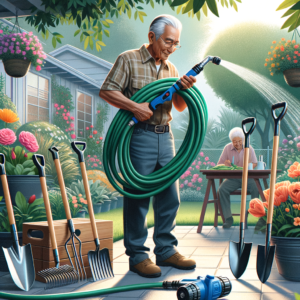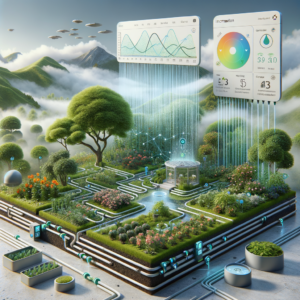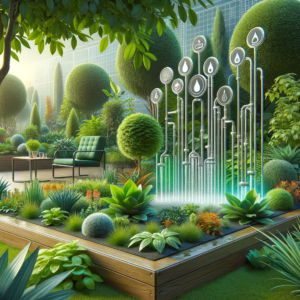In the realm of adaptive gardening, where accessibility and ease of maintenance are paramount, integrating water conservation techniques is not just environmentally responsible—it’s a practical approach to creating sustainable, low-maintenance gardens. This comprehensive guide explores various water conservation methods tailored for adaptive gardens, ensuring that gardeners of all abilities can contribute to environmental stewardship while enjoying their outdoor spaces.
Importance of Water Conservation in Adaptive Gardening
- Environmental Stewardship: Reduces overall water consumption and supports ecosystem health
- Cost Savings: Lowers water bills and reduces long-term garden expenses
- Reduced Maintenance: Less frequent watering means less physical effort required
- Plant Health: Proper water management leads to stronger, more resilient plants
- Sustainability: Ensures long-term viability of garden spaces
- Community Impact: Sets an example for responsible resource use
Plant Selection for Water Efficiency
- Native Plants:
- Adapted to local climate conditions
- Require less supplemental watering once established
- Drought-Tolerant Species:
- Succulents, lavender, sage, and other water-wise plants
- Thrive with minimal watering
- Deep-Rooted Plants:
- Access water from deeper soil layers
- Require less frequent surface watering
- Grouping by Water Needs:
- Arrange plants with similar water requirements together
- Allows for targeted, efficient watering
Soil Management for Water Retention
- Soil Amendments:
- Add organic matter to improve water retention
- Use compost or well-rotted manure
- Soil Testing:
- Understand soil composition and adjust accordingly
- Ensure proper pH for optimal water absorption
- Aeration:
- Improve soil structure to enhance water penetration
- Use adaptive tools for easy aeration
- Erosion Control:
- Prevent water runoff with proper landscaping techniques
- Use ground covers and terracing where appropriate
Efficient Irrigation Techniques
- Drip Irrigation:
- Delivers water directly to plant roots
- Reduces water loss through evaporation
- Soaker Hoses:
- Provide slow, deep watering
- Easy to install and maintain
- Smart Sprinkler Systems:
- Adjust watering based on weather conditions
- Can be controlled remotely for accessibility
- Hand Watering with Efficient Tools:
- Use watering wands or nozzles with adjustable flow
- Focus on root zones to minimize waste
Rainwater Harvesting Systems
- Rain Barrels:
- Collect rainwater from roof runoff
- Easy to install and use
- Cisterns:
- Larger capacity for significant water storage
- Can be underground or above ground
- Rain Gardens:
- Capture and filter rainwater runoff
- Provide habitat for wildlife
- Permeable Surfaces:
- Allow rainwater to seep into the ground
- Reduce runoff and replenish groundwater
Mulching Strategies for Water Conservation
- Organic Mulches:
- Use materials like bark, straw, or compost
- Retain soil moisture and suppress weeds
- Inorganic Mulches:
- Gravel or stone for long-lasting coverage
- Reflect sunlight to keep soil cool
- Living Mulches:
- Use ground cover plants to protect soil
- Adds visual interest while conserving water
- Proper Application:
- Apply 2-4 inches of mulch around plants
- Keep mulch away from plant stems to prevent rot
Adaptive Watering Tools and Technologies
- Lightweight, Expandable Hoses:
- Easy to maneuver for those with limited strength
- Moisture Sensors:
- Indicate when plants need watering
- Prevent overwatering
- Automatic Timers:
- Set watering schedules for consistent care
- Useful for those who may forget to water
- Wand Attachments:
- Extend reach without bending or stretching
- Provide precise watering control
Garden Design for Water Efficiency
- Xeriscaping:
- Landscape design that reduces or eliminates the need for irrigation
- Uses drought-tolerant plants and efficient watering methods
- Raised Beds:
- Improve drainage and soil quality
- Can be designed for easy access
- Terracing:
- Reduces water runoff on slopes
- Creates level planting areas
- Shade Planning:
- Use trees or structures to shade water-sensitive plants
- Reduces evaporation and plant stress
Greywater Recycling in the Garden
- Simple Greywater Systems:
- Redirect water from sinks or washing machines to the garden
- Use biodegradable soaps to ensure plant safety
- Constructed Wetlands:
- Natural filtration systems for greywater
- Provide habitat and visual interest
- Laundry-to-Landscape Systems:
- Easy-to-install systems for reusing laundry water
- Require minimal maintenance
- Legal Considerations:
- Check local regulations regarding greywater use
- Ensure compliance with health and safety standards
Scheduling and Timing Water Usage
- Early Morning Watering:
- Reduces evaporation loss
- Allows plants to dry before evening, preventing disease
- Weather-Based Scheduling:
- Adjust watering based on rainfall and temperature
- Skip watering after significant rain
- Deep, Infrequent Watering:
- Encourages deep root growth
- Increases plant resilience to drought
- Seasonal Adjustments:
- Modify watering schedules based on seasonal needs
- Reduce frequency in cooler months
Monitoring and Adjusting Water Consumption
- Water Meters:
- Track garden water usage
- Identify opportunities for conservation
- Soil Moisture Meters:
- Determine when watering is truly necessary
- Easy to use for gardeners with limited mobility
- Smart Garden Apps:
- Provide watering recommendations based on local conditions
- Often compatible with smart irrigation systems
- Regular System Checks:
- Inspect for leaks or inefficiencies
- Adjust sprinklers or drip systems as plants grow
Educating and Engaging the Community
- Demonstration Gardens:
- Create accessible water-wise garden displays
- Showcase various conservation techniques
- Workshops and Classes:
- Offer adaptive gardening classes focusing on water conservation
- Provide hands-on experience with water-saving tools
- Community Challenges:
- Organize water-saving competitions among local gardeners
- Recognize and reward successful conservation efforts
- Resource Sharing:
- Establish tool-lending libraries for water-efficient gardening equipment
- Create networks for sharing knowledge and experiences
Conclusion
Water conservation in adaptive gardening is not just about saving a precious resource; it’s about creating sustainable, low-maintenance gardens that can be enjoyed by people of all abilities. By implementing these water-wise techniques, adaptive gardeners can reduce their environmental impact, lower maintenance requirements, and create resilient, beautiful outdoor spaces.
From thoughtful plant selection and efficient irrigation to innovative garden designs and community engagement, there are numerous ways to incorporate water conservation into adaptive gardening practices. These methods not only benefit the environment but also make gardening more accessible and enjoyable for individuals with varying physical capabilities.
Remember, every drop saved contributes to a more sustainable future. By adopting these water conservation techniques, adaptive gardeners can play a significant role in responsible resource management while continuing to reap the many benefits of gardening.
FAQ
- Q: Can water conservation techniques really make a difference in a small adaptive garden? A: Absolutely! Even small-scale water conservation efforts can significantly reduce water usage and set a positive example in the community.
- Q: Are drought-tolerant plants less attractive than traditional garden plants? A: Not at all. Many drought-tolerant plants offer beautiful flowers, interesting foliage, and unique textures, adding diversity and appeal to gardens.
- Q: How can I make rainwater harvesting accessible if I have limited mobility? A: Consider installing rain barrels with pump systems or gravity-fed irrigation to make collected rainwater easy to use without heavy lifting.
- Q: Is it expensive to implement water conservation techniques in an existing garden? A: While some methods may require initial investment, many techniques like mulching and adjusting watering schedules are low-cost and can lead to long-term savings.
- Q: How do I balance water conservation with the needs of a vegetable garden? A: Focus on efficient irrigation methods like drip systems, use mulch to retain moisture, and choose vegetable varieties that are well-suited to your local climate.



